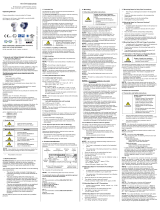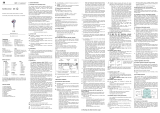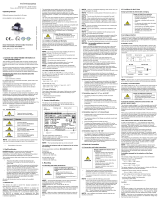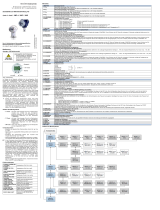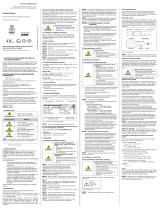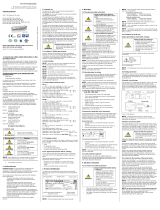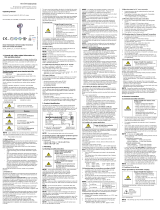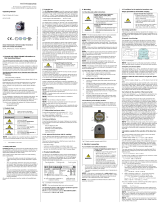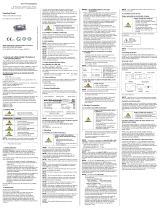Page is loading ...

EN
www.bdsensors.com
BA_XMD_EX_E_SRO
Operating Manual
Differential-Pressure Transmitter for Process Industry
AX2-XMD / AX7-XMD
Headquarter Eastern Europe
BD SENSORS s.r.o.
Hradišťská 817
CZ - 687 08 Buchlovice
Czech Republic
Tel.: +420 572 411 011
Fax: +420 572 411 497
Headquarter Western
Europe / International
BD SENSORS GmbH
BD-Sensors-Str. 1
D - 95199 Thierstein
Germany
Tel.: +49 (0) 92 53 / 98 11-0
Fax: +49 (0) 92 53 / 98 11-11
Russia
BD SENSORS RUS
39a, Varshavskoe shosse
RU - Moscow 117105
Russia
Tel: +7 (0) 9 59 81 / 09 63
Fax: +7 (0) 9 57 95 / 07 21
further agencies in:
EUROPE
• Belgium
• Denmark
• Finland
• France
• Great Britain
• Greece
• Italy
• Lithuania
• Luxemburg
• Netherlands
• Norway
• Poland
• Portugal
• Romania
• Sweden
• Switzerland
• Slovakia
• Spain
• Turkey
• UK
• Ukraine
AFRICA
• Egypt
• South Africa
ASIA
• India
• Iran
• Israel
• Japan
• Kazakhstan
• Malaysia
• Singapore
• Taiwan
• Thailand
• Vietnam
AUSTRALIA
The addresses of our distribution partners are listed on our
homepage www.bdsensors.com. It is possible to download
data sheets, operating manuals, ordering codes and certifi-
cates, as well.
Table of contents
1. General information
2. Product identification
3. Mechanical installation
4. HART
communication
5. Special regulations for IS-areas
6. Electrical Installation
7. Initial start-up
8. Operation
9. Error handling
10. Placing out of service
11. Maintenance
12. Service / Repair
13. Disposal
14. Warranty conditions
15. Declaration of conformity / CE
1. General information
1.1 Information on the operating manual
This operating manual contains important information on
proper usage of the device. Read this operating manual
carefully before installing and starting up the pressure
measuring device.
Adhere to the safety notes and operating instructions which
are given in the operating manual. Additionally applicable
regulations regarding occupational safety, accident preven-
tion as well as national installation standards and engineer-
ing rules must be complied with!
For the installation, maintenance and cleaning of the device,
you must absolutely observe the relevant regulations and
stipulations on explosion protection (VDE 0160, VDE 0165 or
DIN EN 60079-14) as well as the occupational safety provi-
sions.
The device was constructed acc. to standards
EN IEC 60079-0:2018, EN 60079-11: 2012, EN 60079-
26:2015.
This operating manual is part of the device, must be kept
nearest its location, always accessible to all employees.
This operating manual is copyrighted. The contents of this
operating manual reflect the version available at the time of
printing. It has been issued to our best knowledge. However,
errors may have occurred. BD SENSORS is not liable for any
incorrect statements and their effects.
– Technical modifications reserved –
1.2 Symbols used
DANGER! – dangerous situation, which may result in
death or serious injuries
WARNING! – potentially dangerous situation, which
may result in death or serious injuries
CAUTION! – potentially dangerous situation, which
may result in minor injuries
!
CAUTION! – potentially dangerous situation, which may
result in physical damage
NOTE – tips and information to ensure a failure free
operation
1.3 Target group
WARNING! To avoid operator hazards and damages of
the device, the following instructions have to be worked
out by qualified technical personnel.
1.4 Limitation of liability
By non-observance of the operating manual, inappropriate
use, modification or damage, no liability is assumed and
warranty claims will be excluded.
1.5 Intended use
- The Differential Pressure Transmitter XMD has been
especially designed for the process industry and can be
used for level measurement of closed, pressurized
tanks, pump or filter controlling, etc.
The transmitter is as a standard equipped with HART
®
-
communication and the parameterisation can be done
via PC, HART
®
-communicator, etc.
- This operating manual applies to devices with explosion
protection approval and is intended for the use in IS-
areas. A device has an explosion protection approval if
this has been specified in the purchase order and con-
firmed in our order confirmation. In addition, the manu-
facturing label contains the -symbol.
- It is the operator's responsibility to check and verify the
suitability of the device for the intended application. In
addition it has to be ensured, that the medium is com-
patible with the media wetted parts. If any doubts re-
main, please contact our sales department in order to
ensure proper usage. BD SENSORS is not liable for
any incorrect selections and their effects!
- The technical data listed in the current data sheet are
engaging and must be complied with. If the data sheet
is not available, please order or download it from our
homepage. (http://www.bdsensors.com/products/down-
load/datasheets)
WARNING! Danger through improper usage!
1.6 Safety technical maximum values
1.6.1 Intrinsically safe version
AX2-XMD: IBExU05ATEX1105 X
permissible temperatures for environment:
application in zone 0 (p
atm
0.8 bar up to 1.1 bar):
-20 ... 60 °C
application in zone 1 and 2: -40 ... 70 °C
supply and signal circuit:
U
i
= 28 V, I
i
= 98 mA, P
i
= 680 mW, C
i
≈ 0 nF, L
i
≈ 0 µH
plus cable inductivity 1 µH/m and cable capacity 160
pF/m (for cable by factory)
The internal capacity of supply connections compared
to the housing is max. 33 nF
NOTE - The limit values are valid only for the devices
with own-sure circuits!
1.6.2. Special conditions
- The equipment designed with connector have to be
installed in such a way, that the Degree of protection
IP20 always will be kept.
- The safety and assembly notes contained in the operat-
ing instructions and the Ambient temperature range from
-40 °C to +70 °C have to be observed.
- At pressure transmitter with the marking category ½
equipment, the sensor diaphragm serves as partition
wall and has to be protected against mechanical dam-
ages.
- The isolation of the intrinsically circuit opposite the case
is because of leakage flows in the blocking capacitors
from the EMV-boards limited.
1.6.3 Flameproof enclosure
AX7-XMD: IBExU 12 ATEX 1073 X
zone 1: II 2G Ex db IIC T5 Gb
permissible temperatures: -20 ... 70 °C
NOTE – The use of the devices with flameproof
enclosure is not allowed in the areas of dust!
1.7 Package contents
Please verify that all listed parts are included in the delivery
and check for consistency specified in your order:
- differential pressure transmitter
- protective cap
- this operating manual
-
1.6.4. Special conditions for safe use
- The pressure transmitters type AX7-XMP i, AX7-XMP ci
and AX7-XMD can be used in an ambient temperature range
from -20°C up to +70 °C.
- The cable entry (M20x1.5) supplied by the manufactur-
er may be used only for fixed installation. The operating
company has to ensure an appropriate clamping.
2. Product identification
The device can be identified by its manufacturing labels.
It provides the most important data. By the ordering code the
product can be clearly identified.
!
The manufacturing labels must not be removed from the
device!
3. Mechanical installation
3.1 Mounting and safety instructions
WARNING! Install the device only when depressurized
and currentless!
WARNING! This device may only be installed by
qualified technical personnel who has read and under-
stood the operating manual!
DANGER! Caused by the explosion hazard following
instructions have to be complied with:
- The technical data listed in the EC type-
examination certificate are engaging and must ab-
solutely be complied with. If the certificate is not
available, please order or download it from our
homepage: http://www.bdsensors.com/products/
download/certificates
- Working on supplied (active) parts, except for in-
trinsically safe circuits, is principally prohibited dur-
ing an explosion hazard.
- Make sure that an equipotential bonding is in
place for the entire course of the line, both inside
and outside the intrinsic area.
- In case of increased danger of lightning strike or
damage by overvoltage, a stronger lightning pro-
tection should be planned.
- Observe the limiting values specified in the EC
type-examination certificate. (Capacitance and in-
ductance of the connection cable are not included
in the values.)
- Make sure that the entire interconnection of intrin-
sically safe components remains intrinsically safe.
The operator is responsible for the intrinsic safety
of the overall system (installation of intrinsic parts).
- Do not mount the device in a pneumatic flow rate!
- Excessive dust deposits (over 5 mm) and a com-
plete dust covering must be avoided!
- When installing the device, at least the ingress pro-
tection IP 20 must be realised.
!
Handle this high-sensitive electronic precision
measuring device with care, both in packed and
unpacked condition!
!
There are no modifications/changes to be made on the
device.
!
Do not throw the package/device!
!
To avoid damaging the diaphragm, remove packaging
and protective cap directly before starting assembly.
The delivered protective cap has to be stored!
!
Place the protective cap on the pressure port again
immediately after disassembling.
!
Handle the unprotected diaphragm very carefully - it is
very sensitive and may be easily damaged.
!
Do not use any force when installing the device to pre-
vent damage of the device and the plant!
!
For installations outdoor and in damp areas following
these instructions:
- To prevent moisture admission in the plug the de-
vice should be installed electrically after mounting,
at once. Otherwise a moisture admission has to be
blocked e.g. by using a suitable protection cap.
(The ingress protection in the data sheet is valid for
the connected device.)
- Choose an assembly position, which allows the
flow-off of splashed water and condensation. Avoid
permanent fluid at sealing surfaces!
- When using a device with cable outlet, turn the
outgoing cable downwards. If the cable has to be
turned upwards, then point it downward so the
moisture can drain.
- Install the device in such a way that it is protected from
direct solar irradiation. Direct solar irradiation can lead to the
permissible operating temperature being overstepped in the
worst case. This is prohibited for applications in IS-areas!
When installing the device to the pressurized system,
the operator has to ensure the correct sealing.
Check the intended resp. delivered seal for compatibility
with the medium. If there is no compatibility, take a suit-
able seal.
Take note that no assembly stress occurs at the
pressure port, since this may cause a shifting of the
characteristic curve. This is especially important for very
small pressure ranges as well as for devices with a
pressure port made of plastic.
In hydraulic systems, position the device in such a way
that the pressure port points upward (ventilation).
Provide a cooling line when using the device in steam
piping.
3.2 General installation steps
- Carefully remove the pressure measuring device from
the package and dispose of the package properly.
- Go ahead as detailed in the specific instructions below.
3.3 Installation steps for NPT connections
- Use a suitable seal, corresponding to the medium and
the pressure input (e. g. a PTFE-strip).
- Screw the device into the corresponding thread by
hand.
- Tighten it with a wrench (for 1/2" NPT: approx. 70 Nm).
3.4 Positioning of the display and operating module
The display and operating module is continuously rotatable
so that clear readability is guaranteed even in unusual
installation positions. To change the position go ahead as
follows:
- Screw off the metal cap by hand.
- Turn the display and operating module carefully into the
desired position by hand. The module is equipped with
a rotational limiter.
- Before screwing on the cap again, the o-ring and seal-
ing surfaces of the housing have to be checked for
damage and if necessary have to be changed!
- Afterwards screw the metal cap on by hand and make
sure that the housing is firmly locked again.
WARNING! It is prohibited to open and configure the
devices in the presence of explosion hazards. Therefore
it is recommended to position the display and operating
module together with the mechanical installation.
!
Pay attention that no moisture can enter the device.
Moreover, the seals and the sealing surfaces should not
get dirty, as this may cause a reduction of the degree of
protection depending on the case of application or place
of installation. This can lead to a breakdown of the de-
vices or to irreparable damages on the device.
4. HART
communication
DANGER! It is prohibited to interrupt the intrinsically
safe circuit in the presence of explosion hazards in or-
der to loop in a HART
communication interface
(HART
-communicator or HART
-modem).
The analogue output signal is overridden by an additional
signal according to the HART
-specification. The device can
be configured via a HART
-communication device. Therefore
we suggest our programming kit CIS 150 (available as
accessory).
To ensure a trouble-free operation the following require-
ments should be fulfilled:
maximal cable length between device and power supply:
VVV
CCR
L
36
max
10401065 ⋅
−
⋅
⋅
=
whereas L
max
: maximum length of cable in [m]
R
V
: resistance of the cable together with
the load resistance in [Ω]
C
V
: capacity of the cable in [pF/m]
resistance R:
Ω
−
=024,0 12U
R
whereas U: power supply in [V
DC
]
The resistance must be at least 240 Ω.
5. Special regulations for IS-areas
5.1 Protection against electrostatic charge hazards
Different types of the device partially consist of chargeable
plastic components. These are in particular coating of the
housing as well as the plastic pressure port (optionally). A
potential electrostatic charge presents the danger of spark
generation and ignition. An electrostatic charge must there-
fore be absolutely prevented.
Generally, a shielded cable must be used.
Avoid friction on the plastic surfaces!
Do not clean the device dry! Use, for example, a damp
cloth.
The following warning sign is, if applicable, attached to the
device. It points once more to the hazard of electrostatic
charging.
Fig. 2 warning sign
!
The warning sign must not be removed from the device!
5.2 Overvoltage protection
If the device is used as electrical equipment of category 1 G,
a suitable overvoltage protection device must be connected
in series (attend the valid regulations for operating safety as
well as EN60079-14).
5.3 Schematic circuit
The operation of an intrinsically safe transmitter in intrinsic
safe areas requires special care when selecting the neces-
sary Zener barrier or transmitter repeater devices to allow
the utilization of the device’s properties to the full extent.
The following diagram shows a typical arrangement of power
supply, Zener barrier and pressure transmitter.
Fig. 3 Circuit diagrams
!
Please pay attention to item (17) of the type examina-
tion certificate, which stipulates special conditions for in-
trinsically safe operation.
5.4 Exemplary circuit description
The supply voltage of e. g. 24 V
DC
provided by the power
supply is led across the Zener barrier. The Zener barrier
contains series resistances and Zener diodes as protective
components. Subsequently, the operating voltage is applied
to the device and, depending on the pressure a particular
signal current will flow.
DANGER! When installing the intrinsically safe device
as a zone-0-equipment, the supplying must be carried
out by a power supply which must be galvanically insu-
lated and which is not allowed to be grounded.
5.5 Functional selection criteria for Zener barriers and
galvanic power supply
The minimum supply voltage V
S
min
of the device must not fall
short since a correct function of the device can otherwise not
be guaranteed. The minimum supply voltage has been
defined in the respective product-specific data sheet under
"Output signal / Supply".
When using a galvanically insulated amplifier with a linear
bonding, please attend that the terminal voltage of the device
will decrease like it does with a Zener barrier. Furthermore, it
has to be attended that the supply of the device will also
decrease with an optionally used signal amplifier.
5.6 Test criteria for the selection of the Zener barrier
In order not to fall below V
S min
, it is important to verify which
minimum supply voltage is available at full level control of the
device. Full level control, i. e. a maximum or nominal output
signal (20 mA), can be reached by applying the maximum
physical input signal (pressure).
The technical data of the barrier will usually provide the
information needed for the selection of the Zener barrier.
However, the value can also be calculated. If a maximum
signal current of 0.02 A is assumed, then – according to
Ohm’s law – a particular voltage drop results on the series
resistance of the Zener barrier. This voltage drop is subtract-
ed from the voltage of the power supply and as a result, the
terminal voltage is obtained which is applied on the device at
full level control. If this voltage is smaller than the minimum
supply voltage, another barrier or a higher supply voltage
should be chosen.
Please pay attention when choosing the barrier or the
transmitter repeater because some supplied devices /
Zener barriers are not suitable for HART
communica-
tion. Most manufacturers offer a device group especially
developed for this application.
When selecting the ballasts, the maximum operating
conditions according to the EC type-examination certifi-
cate must be observed. When assessing these, refer to
their current data sheets to ensure that the entire inter-
connection of intrinsically safe components remains in-
trinsically safe.
6. Electrical Installation
WARNING! Install the device in currentless environ-
ments only!
WARNING! Install the connection for devices equipped
with terminal clamps so that the separating spaces
comply with the standard and the connecting lines can-
not be loosened.
By devices with pressure flameproof enclosure a cable
gland M20x1.5 with the name HSK-M-Ex-d is pre-
scribed. This is already premounted.
DANGER! Danger of explosion when surpassing the
maximum supply of 28 V
DC
!
NOTE – The cap for the connection clamps and display
can be opened only if a locking protection, headless
screw with inside hexagonal, remove became. The
screw is on the right side below the cap. After attach of
the cap for display and for the connection clamps, the
locking protection must be screwed again purely. Be-
sides, the lubrication of the thread ways is not neces-
sary.
NOTE - The cable gland by devices with flameproof
enclosure is suitable only for the firm transfer!
Establish the electrical connection of the device according to
the technical data shown on the manufacturing label, the
following table and the wiring diagram.
Pin configuration:
Electrical
connections
Terminal clamps in clamping chamber with
cable gland M 20 x 1,5
(for cable Ø 5 up to 14 mm)
Supply +
Supply –
Test
COM / Test –
COM
+
-
TEST+
COM/TEST-
COM
Shield
Wiring diagram:
2-wire system (current) HART
!
For the installation of a device with cable outlet following
bending radiuses have to be complied with:
cable without ventilation tube:
static installation : 8-fold cable diameter
dynamic application:12-fold cable diameter
cable with ventilation tube:
static installation : 10-fold cable diameter
dynamic application:20-fold cable diameter
!
Prevent the damage or removal of the PTFE filter which
is fixed over the end of the air tube on devices with
cable outlet and integrated air tube.
!
To install a device with terminal clamps, the cap has to
be screwed off. If the device is equipped with a display
and operating module, this has to be pulled out careful-
ly. Put it as long as installing the device non-tensioned
next to the housing. Next insert it again carefully and
safety
technical
maximum
values
Ex-designation and
number of EC type examination certificate
ordering code
supply
setting range
signal
serial
number
code of
nominal range
p
supply +
supply –
V
S
I
Fig. 1 manufacturing labels – for AX2- example

BA_XMD_EX_E_SRO_23.11.2020
ensure that the cords are not turned or squeezed. Be-
fore screwing on the cap again, the o-ring and sealing
surfaces of the housing have to be checked for damage
and if necessary to be changed! Afterwards screw the
metal cap on by hand and make sure that the field
housing is firmly locked again.
!
For a clear identification, the intrinsically safe cables are
marked with light blue shrink tubing (over the cable in-
sulation). If the cable has to be modified (e. g. short-
ened) and the marking at the cable end has been lost in
the process, it must be restored (for example, by mark-
ing it again with light blue shrink tubing or an appropri-
ate identification label).
For the electrical connection a shielded and twisted
multicore cable has to be used.
7. Initial start-up
WARNING! Before start-up, the user has to check for
proper installation and for any visible defects.
WARNING! The device can be started and operated by
authorized personnel only, who have read and under-
stood the operating manual!
WARNING! The device has to be used within the
technical specifications, only (compare the data in the
data sheet and the EC type-examination certificate)!
8. Operation
8.1 Display- and operating modul
A bargraph is shown in the display, indicating the current
pressure input as percentage of the specified pressure
range. The indication of the measured value as well as the
configuration of the individual parameters occurs through a
menu via the display. The individual functions can be set
with the help of three miniature push buttons located under
the metal cap. For XMP is additionally the possibility given to
operate via three push buttons (accessible from above). This
is especially an advantage in IS-areas, caused by the fact
that the device can be configured in situ without opening the
operating and display module. Therefore the metal plate (on
the top side of the device), has to be folded backwards after
loosening the right screw. The definition of the three buttons
is: ▼, OK, ▲ (starting at the left side).
The menu system is a closed system allowing you to scroll
both forward and backward through the individual set-up
menus to navigate to the desired setting item. All settings are
permanently stored in a Flash EPROM and therefore availa-
ble even after disconnecting from the supply voltage.
WARNING! It is prohibited to open and configure the
devices in the presence of explosion hazards. After con-
figuration it must be ensured that the device is com-
pletely closed again outside the explosion hazard area.
!
Pay attention that no moisture can enter the device
during configuration. Moreover, the seals and the seal-
ing surfaces should not get dirty, as this may cause a
reduction of the degree of protection depending on the
case of application or place of installation. This can lead
to a breakdown of the device or to irreparable damages
on the device. Right after configuration, the metal cap
has to be screwed on again.
8.2 Structure of the menu system
See arranged supplementary sheet (supplementary sheet /
structure of the menu system). This supplementary sheet
should only be used with this operating manual.
8.3 Menu list
-
▲-button: with this button you move forward in the
menu system or increase the displayed value; it will al-
so lead you to the operating mode (beginning with
menu item "1 DISPLAY")
-
▼-button: with this button you move back in the
menu system or decrease the displayed value; it will
also lead you to the operating mode (be-
ginning with menu item "5 SERVICE")
-
OK-button: with this button menu items and set values
have to be confirmed
execution of configuration:
- set the desired menu item by pushing the ▲- or ▼-
button
- activate the set menu item by pushing the OK-button
- set the desired value or select one of the offered set-
tings by using the ▲- or ▼-button
- store/confirm the set value/selected setting and exit the
menu by pushing the OK-button.
10. Placing out of service
WARNING! Disassemble the device only in current and
pressure less condition! Check before disassembly, if it
is necessary to drained off the media before disman-
tling!
WARNING! Depending on the medium, it may cause
danger for the user. Comply therefore with adequate
precautions for purification.
11. Maintenance
In principle, this device is maintenance-free. If desired, the
housing of the device can be cleaned when switched of
using a damp cloth and non-aggressive cleaning solutions.
Depending on the measuring medium, however, the dia-
phragm may be polluted or coated with deposit. If the medi-
um is known for such tendencies, the user has to set appro-
priate cleaning intervals. After placing the device out of
service correctly, the diaphragm can usually be cleaned
carefully with a non-aggressive cleaning solution and a soft
brush or sponge. If the diaphragm is calcified, it is recom-
mended to send the device to BD SENSORS for decalcifica-
tion. Please read therefore the chapter “Repair” below.
!
An incorrect cleaning can cause irreparable damages
on the diaphragm. Never use spiky objects or pressured
air for cleaning the diaphragm.
12. Service/Repair
12.1 Recalibration
During the life-time of a transmitter, the value of offset and
span may shift. As a consequence, a deviating signal value
in reference to the nominal pressure range starting point or
end point may be transmitted. If one of these two phenome-
na occurs after prolonged use, a recalibration is recom-
mended to ensure furthermore high accuracy.
12.2 Return
Before every return of your device, whether for recalibration,
decalcification, modifications or repair, it is necessary to
contact us to ensure a fast handling of your request. Please
Include the number of devices sent and request a RMA.
Then clean the device and pack it shatterproof before send it
to BD SENSORS indicating the RMA.
13. Disposal
The device must be disposed according to the
European Directives 2002/96/EC and
2003/108/EC (on waste electrical and electronic
equipment). Waste of electrical and electronic
equipment may not be disposed by domestic
refuse!
WARNING! Depending on the measuring medium,
deposit on the device may cause danger for the user
and the environment. Comply with adequate precau-
tions for purification and dispose of it properly.
14. Warranty conditions
The warranty conditions are subject to the legal warranty
period of 24 months from the date of delivery. In case of
improper use, modifications of or damages to the device, we
do not accept warranty claims. Damaged diaphragms will
also not be accepted. Furthermore, defects due to normal
wear are not subject to warranty services.
15. Declaration of conformity / CE
The delivered device fulfils all legal requirements. The
applied directives, harmonised standards and documents are
listed in the EC declaration of conformity, which is available
online at www.bdsensors.com.
Additionally, the operational safety is confirmed by the CE
sign on the manufacturing label.
Abb.
4 Bedienfolie
OK-button
bargraph
▼-button ▲-button
display
Fig. 4 touch pad
Malfunction
Possible cause Error detection / corrective
display does not
work
falsely connected inspect the connections
line break inspect all connecting lines of the device
(including the connector plugs)
defective energy supply inspect the power supply and the applied supply voltage at the
transmitter
no output signal
wrong connected inspect the connection
line break inspect all line connections necessary to supply the device (including
the connector plugs)
defective amperemeter (signal
input) inspect the amperemeter (fine-wire fuse) or the analogue input of the
PLC
analogue output
signal too low
load resistance too high verify the value of the load resistance
supply voltage too low verify the output voltage of the power supply
defective energy supply inspect the power supply and the applied supply voltage at the device
small shift of
output signal
diaphragm is highly contaminated careful cleaning with non-aggressive cleaning solution and a soft
brush or sponge; incorrect cleaning can cause irreparable damages on
diaphragm or seals
diaphragm is calcified or coated
with deposit if possible it is recommended to send the device to BD SENSORS for
decalcification or cleaning
large shift of
output signal diaphragm is damaged (caused
by overpressure or manually) check the diaphragm; if it is damaged, please send the device to
BD SENSORS for repair
measured value
(display and
analogue output)
deviates from the
nominal value
high pressure / pressure peaks a recalibrated or replaced of the pressure port by BD SENSORS is
necessary
mechanical damage to diaphragm
constant output
signal at 4 mA wrong ID-number ensure in the menu item "ID" that the set value for the ID-number is
"0000"
If you detect an error, please try to eliminate it by using this table or send the device to our service address for repair.
DANGER! Working on supplied (active) parts, except for intrinsically safe circuits, is principally prohibited during an explo-
sion hazard. Additionally, the operator is obligated to observe the information concerning operation and maintenance work
on the warning signs possibly affixed to the device.
!
Improper action and opening can damage the device. Therefore repairs on the device may only be executed by the
manufacturer!
9. Error handling
9.1 Error messages
PASSED PARAMETER TOO SMALL passed parameter value is too small
PASSED PARAMETER TOO LARGE passed parameter value is too large
LOOP CURRENT NOT ACTIVE
loop current is not active (HART ID > 0, device work in mode Multidrop)
APPLIED PROCESS TOO LOW applied process is too low
APPLIED PROCESS TOO HIGH applied process is too high
LOWER RANGE VALUE TOO HIGH lower range value (OFFSET) is too high
LOWER RANGE VALUE TOO LOW lower range value (OFFSET) is too low
UPPER RANGE VALUE TOO HIGH upper range value (FINALVAL) is too high
UPPER RANGE VALUE TOO LOW upper range value (FINALVAL) is too low
SPAN TOO SMALL span too small
If a parameter is configurable by a value, each digit may be configured separately. That means after activating such a menu
item (e. g. "2.3.1 OFFSET") by pushing the OK-button, the first digit of the currently set value will start to blink. Now scroll up
or down to the desired digit via the ▼- or ▲-button and confirm it with the OK-button. After that, the next digit will start to
blink. Configure it in the same way. In the menu items "2.3.1 OFFSET" and "2.3.2 FINALVAL", the decimal point will then
start to blink and it is also possible to change its position by using the ▼- or ▲-button. By confirming the position with the
OK-button, the total value will be stored if permissible. If the value is out of range, an error message (e. g. Error 03) will ap-
pear in the display and the set value will not be stored. If you intend to set a negative value, the first digit has to be config-
ured with the ▼-button.
1 DIPLAY
Display
1.1 P
max
Maximum pressure display (high pressure)
The maximum pressure applied during measuring is shown in the display.
1.2 P
min
Minimum pressure display (low pressure)
The minimum pressure applied during measuring is shown in the display.
1.3 T
max
Maximum temperature display (high temperature)
The minimum temperature during measuring is shown in the display.
1.4 T
min
Minimum
pressure display (high pressure)
The maximum pressure applied during measuring is shown in the display.
1.5 CLEAR
Use to clear the values 1.1-1.4 (P
max
, P
min
, T
max
, T
min
)
1.6 INFO
Setting of the display
meaning of the permissible numbers:
"1": 1. line: measured pressure 2. line: set pressure unit
"2": 1. line: output signal 2. line: mA
"3": 1. line: measured temperature 2. line: °C
"4": 1. line: measured pressure 2. line: changes between set pressure unit / output signal in mA
"5": 1. line: measured pressure 2. line: changes between set pressure unit /
measured temperature in °C
"6": 1. line: measured pressure 2. line: changes between set pressure unit / output signal in mA /
measured temperature in °C
2 CALIB
Calibration
2.1 ZERO
Offset correction
By choosing the submenu 2.1 with the OK-button, „CONFIRM“ appears in the display. By pushing the OK-
button for at least 2 seconds, the correction is carried out and „CONFIRM“ disappears in the display.
2.2 CAL REF
Calibration reference
2.2.1 OFFSET
Offset calibration
After feeding and adoption of reference value, choose the submenu 2.2.1 with the OK-button, „CONFIRM“
appears in the display. By pushing the OK-button for at least 2 seconds, the calibration is carried out and
„CONFIRM“ disappears in the display.
2.2.2 FINALVAL
Final value calibr
at
ion
After feeding and adoption of reference value, choose the submenu 2.2.2 with the OK-button, „CONFIRM“
appears in the display. By pushing the OK-button for at least 2 seconds, the calibration is carried out and
„CONFIRM“ disappears in the display.
2.3 ADJUST
Adjust
2.3.1 OFFSET
Setting of the initial value of the
measuring range
With button▲ and ▼ you can set a initial value of measuring range. The value of new range is max. 100:1
(or 30:1, depending on the range).
2.3.2 FINALVAL
Setting of the terminal value of the measuring range
With button▲ and ▼ you can a terminal value of measuring range. The value of new range is max. 100:1
(or 30:1, depending on the range).
2.3.3 Z-CORR
Resetting the offset
By choosing the submenu 2.3.3 with the OK-button, „CONFIRM“ appears in the display. By pushing the OK-
button for at least 2 seconds, the resetting is carried out and „CONFIRM“ disappears in the display.
3 SIGNAL
Signal
3.1 FUNKTION
Function selection e.g. "LINEAR" (linear function)
3.2 DENSITY
Input the density [kg/m
3
]. The unit will be changed to [mFs]
3.3 DAMP
Setting of the damping
permissible range: from 0 up to 100 sec
3.4 SIMULAT
Free input of output signal [mA] for simulation of plant conditions (from 3,8 ... 21,6 mA)
4 SETTINGS
Settings
4.1 DISPLAY
Extension of display
4.1.1 UNIT P
Setting of the pressure unit
permissible units: bar, mbar, g/cm², kg/cm², Pa, kPa, Torr, atm, mmWS (mm H20), mmHg, PSI, FIH
2
O
FIH
2
O- feat H
2
O 20°C
a conversation of all pressure related parameters is carried out automatically
4.1.2 UNIT T
Setting of the temperature unit
Switching between the unit [°C], [°F] and [K]
4.2 HART-ID
HART
-
ID (only for HART
®
-
devices with multidrop
-
mode to a
d
just)
HART-ID (only with HART
®
- to put to devices in the multi drop mode)
Put the desired ID No. (between "0 and 15") and confirm this with the OK-button. A configuration of this
number is only necessary if you liked to pursue the device in the multi drop mode (connection of several
HART
®
devices). If the ID No. on "0" is put, the multi drop mode is deactivated and the pressure transmitter
works in the analogous mode.
4.3 USER-L
Configuration of the access protection
For security reasons, it is necessary to enter the password before configuring the access protection. Confirm
it with the OK-button. The default setting for the password is "0000".
meaning of the permissible numbers:
"0": the complete menu system is unlocked
"1": following menus are unlocked: 1 DISPLAY, 3 SIGNAL, 4.3 USER-L
"2": following menus are unlocked: 1 DISPLAY, 4.3 USER-L
4.4 PASSW
Configuration of the password
For security reasons, it is necessary to enter the current password before the configuration of the new one.
Confirm with the OK-button. The default setting for the password is "0000". Then set the new password and
confirm with the OK-button.
4.5 LANGUAGE
Choosing of user language [DE] or [EN]
5 SERVICE
Service
5.1 FACTORY
To restore to factory settings
5.2 ERR CURR
Error current limits
Setting of the error current limit value: 21,6 mA or 3,8 mA
5.3 TYPE
Displaying of the type of device
5.4 SER-NO
Displaying of the serial number
5.5 VERS
Displaying of the program version
9.2. More errors and possible
corrections
/

